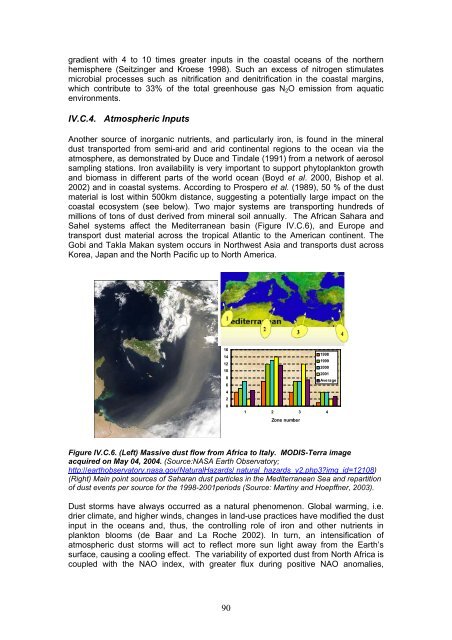Climate Change and the European Water Dimension - Agri ...
Climate Change and the European Water Dimension - Agri ...
Climate Change and the European Water Dimension - Agri ...
Create successful ePaper yourself
Turn your PDF publications into a flip-book with our unique Google optimized e-Paper software.
gradient with 4 to 10 times greater inputs in <strong>the</strong> coastal oceans of <strong>the</strong> nor<strong>the</strong>rn<br />
hemisphere (Seitzinger <strong>and</strong> Kroese 1998). Such an excess of nitrogen stimulates<br />
microbial processes such as nitrification <strong>and</strong> denitrification in <strong>the</strong> coastal margins,<br />
which contribute to 33% of <strong>the</strong> total greenhouse gas N2O emission from aquatic<br />
environments.<br />
IV.C.4. Atmospheric Inputs<br />
Ano<strong>the</strong>r source of inorganic nutrients, <strong>and</strong> particularly iron, is found in <strong>the</strong> mineral<br />
dust transported from semi-arid <strong>and</strong> arid continental regions to <strong>the</strong> ocean via <strong>the</strong><br />
atmosphere, as demonstrated by Duce <strong>and</strong> Tindale (1991) from a network of aerosol<br />
sampling stations. Iron availability is very important to support phytoplankton growth<br />
<strong>and</strong> biomass in different parts of <strong>the</strong> world ocean (Boyd et al. 2000, Bishop et al.<br />
2002) <strong>and</strong> in coastal systems. According to Prospero et al. (1989), 50 % of <strong>the</strong> dust<br />
material is lost within 500km distance, suggesting a potentially large impact on <strong>the</strong><br />
coastal ecosystem (see below). Two major systems are transporting hundreds of<br />
millions of tons of dust derived from mineral soil annually. The African Sahara <strong>and</strong><br />
Sahel systems affect <strong>the</strong> Mediterranean basin (Figure IV.C.6), <strong>and</strong> Europe <strong>and</strong><br />
transport dust material across <strong>the</strong> tropical Atlantic to <strong>the</strong> American continent. The<br />
Gobi <strong>and</strong> Takla Makan system occurs in Northwest Asia <strong>and</strong> transports dust across<br />
Korea, Japan <strong>and</strong> <strong>the</strong> North Pacific up to North America.<br />
16<br />
14<br />
12<br />
10<br />
8<br />
6<br />
4<br />
2<br />
0<br />
Figure IV.C.6. (Left) Massive dust flow from Africa to Italy. MODIS-Terra image<br />
acquired on May 04, 2004. (Source:NASA Earth Observatory;<br />
http://earthobservatory.nasa.gov/NaturalHazards/ natural_hazards_v2.php3?img_id=12108)<br />
(Right) Main point sources of Saharan dust particles in <strong>the</strong> Mediterranean Sea <strong>and</strong> repartition<br />
of dust events per source for <strong>the</strong> 1998-2001periods (Source: Martiny <strong>and</strong> Hoepffner, 2003).<br />
Dust storms have always occurred as a natural phenomenon. Global warming, i.e.<br />
drier climate, <strong>and</strong> higher winds, changes in l<strong>and</strong>-use practices have modified <strong>the</strong> dust<br />
input in <strong>the</strong> oceans <strong>and</strong>, thus, <strong>the</strong> controlling role of iron <strong>and</strong> o<strong>the</strong>r nutrients in<br />
plankton blooms (de Baar <strong>and</strong> La Roche 2002). In turn, an intensification of<br />
atmospheric dust storms will act to reflect more sun light away from <strong>the</strong> Earth’s<br />
surface, causing a cooling effect. The variability of exported dust from North Africa is<br />
coupled with <strong>the</strong> NAO index, with greater flux during positive NAO anomalies,<br />
90<br />
1 2 3 4<br />
Zone number<br />
1998<br />
1999<br />
2000<br />
2001<br />
Average













